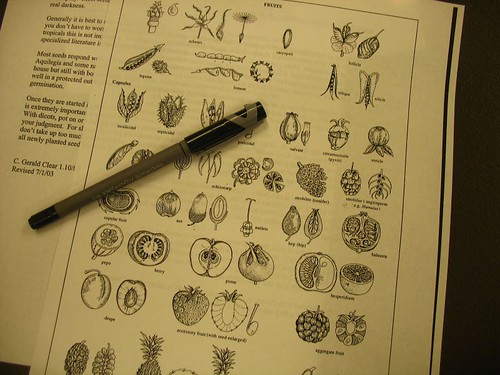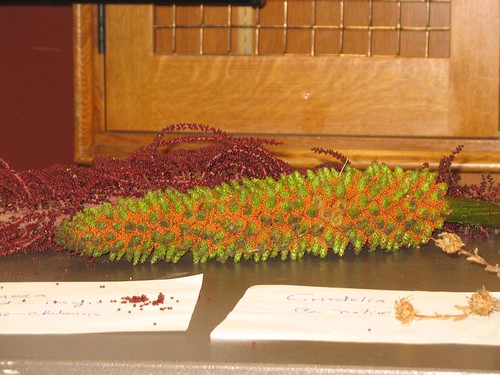Unfortunately, I cannot find my notes anywhere! So this is from memory. Maybe my BFF Kirsten will help me recollect some other interesting details.
1. To grow wild roses from seed, collect the hip before it turns red and sow immediately.
2. Genetic damage from inbred plants shows up in seeds from successive generations, not in seeds collected from the first isolated parent(s). This is one of those things that I find intellectually obvious, but not intuitively obvious. It means that you may grow vigorous plants from seeds collected from an isolated parent (grown from healthy parents) over and over again, but successive generations of offspring from these same vigorous plants will produce weaker and weaker seed.
3. Ethical seed collection. Get permits to collect on public land, and permission to collect on private land. Get permits from the USDA to import or export plant plant material to/from the USA, here. Take no more than 10% of the seed from any plant, or any plant population. Permits to collect can be hard to get. While there is legislation requiring you to have them, there is no mechanism in place for issuing them.
4. Collecting a few seeds from many plants is better than collecting many seeds from one plant.
5. Whenever possible, let seeds clean themselves.
Step #1) Take whole dead or nearly dead inflorescence (or what have you).
Step #2) Put in a paper bag, flowers pointed down.
Step #3) Wait.
Step #4) Collect loose seeds at the bottom of the bag.
6. A subscription to Rock Garden Quarterly is apparently a must for horticulture sophisticates. The Summer 2007 issue has some of the best writing about seed collecting Dr. Mahoney has ever seen.
Note: He also extolled the Deno book (link and link), but did not discuss Deno's passion for giberellic acid (link).
7. He joked about botanists' talent for distinguishing every teensy, tiny, minute micro detail, and why doing so makes perfect sense to botanists (so they can communicate clearly with one another).

No need for amateurs to exert themselves with all the fine distinctions. There are four basic seed vessels to remember: pods, capsules....nuts and berries? (Kirsten, help me out!)
8. Environmental Impact Reports do not typically take account of seed banked in soil. This is a serious flaw from a botanical-ecological perspective since large amounts of viable, quiescent native seeds may reside in a given volume of undisturbed soil. (An anecdote was shared about a forest fire in a redwood grove that yielded a vigorous, valley-wide stand of Ceanothus where no one could recall having seen a Ceanothus before. Within five years, the stump-sprouting redwood trees had shaded out the Ceanothus.)
9. The big thing for the last few years is using smoke to germinate seeds from fire-adapted ecosystems like South Africa and California. The active ingredient is nitric oxide and artificial smokes containing nitric oxide are now available (from two places I won't remember until I find my notes). Smoke is absolutely essential for germinating restio seeds and these artificial smokes will do the trick. (Nearly all grass-like plants fit in to one of four categores: carexes, sedges, rushes, and restios; you could add bamboos and make it five.)
10. Don't lose your notes.

Gunnera tinctoria in front.

8 comments:
What is that page with the seed illustrations in the photo from? I need it! Please & thanks.
MR from G'ville
Man, you are good at recollecting without notes! Sounds like a worthwhile class anyhow. Once I realized how much I'd spent on plants this year, the need for sowing seeds instead is totally obvious to me...so I'm going to try and "osmose" your knowledge...hold still....;-)
Hey, this is good info. I just started some seed of CA native lilies--my first real attempt at growing from seed.
About grasses and grass-like plants:
Bamboos are true grasses.
Carex is the genus of sedges (there are also bulrushes, cotton grasses and others in the sedge family, but they're not true sedges).
Other grass-like plants could include the cattails.
What kind of fancy pen is that?
Great overview. I wish there was a botanical garden nearby.
In systematics, the propagule types we had were:
seed
nut(let)
capsule
achene
berry + aggregate (blackberry, raspberry, etc.)
And these are just for the angiosperms.
You remembered all this?? LOL, I can barely recall what I had for breakfast this morning. :(
I am growing Hybrid tree dahlias here in South Wales UK but am looking for seed of tree dahlia species, any ideas?
david@abacus-nurseries.co.uk
First Class post.
Thank you.
(I'd write more but I think that sums it up.)
Oh... the SF Botanical must be quite a program.
Post a Comment